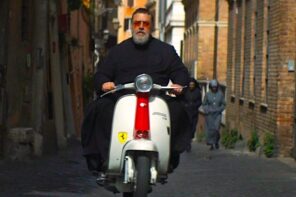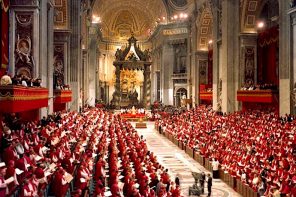In their new book, Women Deacons: Past, Present, Future, Gary Macy, William T. Ditewig, and Phyllis Zagano revisit the question of women’s ordination to the diaconate in the Roman Catholic Church. Unlike ordination to the priesthood, women’s ordination to the diaconate has unambiguous roots in the Christian New Testament, where Phoebe is named as a deacon of the church in Cenchrae (Rm. 16:1). Likewise, Roman Catholic canon law appears to have much more wiggle room with regard to the diaconate.
Macy, Ditewig, and Zagano have been swimming in the often choppy sea of questions around the ordination of women in the Catholic Church for many years. RD contributor Elizabeth Drescher talked with the three writers about how their collaborative project advances the conversation.
How did you come to approach the question of women’s ordination to the diaconate in the way you have in Women Deacons—from historical, theological, and pastoral perspectives?
Gary Macy (GM): The important point to make about the ordination of women deacons in the West is that the concept of ordination changed dramatically in the twelfth and thirteenth centuries just at the time that women stopped being ordained. Soon the claim was made (and is still made) that women had never been ordained since they were ordained under a different understanding of ordination. This theological claim complicates how one reads the evidence. Rather than just looking for evidence that women were ordained (which is plentiful), the further theological argument must be made that these were (or were not) “real” ordinations. At least some churches in the East have decided that the ordinations of women deacons were “real.” For Roman Catholics, the jury on that question is still out.
I saw recently that Paulist Press, your publisher, provided an opportunity for readers to buy copies for the US Catholic bishops. Do you expect that they’ll read the book?
Phyllis Zagano (PZ): I think they will. My own bishop asked for a copy, as did two US cardinals. There is a huge groundswell of support on this issue. For example, the Cleveland-based group FutureChurch has been running a postcard campaign for a year or so, and through FutureChurch thousands of people have sent requests for women deacons directly to Rome with a copy to their local bishops. We have a broad spectrum of donors who have purchased books for bishops, and Paulist has begun sending to diocesan bishops across the country. If we get enough money we’ll send to auxiliary and retired bishops. I believe there are a about 495 bishops in the US Conference of Catholic Bishops.
So the bottom line, yes, if there is one book a bishop should read this year I think this is it.
What’s the most important message you’d want the bishops to take from the book? What about other readers, within and outside the Catholic Church?
William Ditewig (WD): The most important point, I believe, is that we take quite seriously the teaching of the Roman Catholic Church that deacons are not priests; expressed more theologically, deacons do not participate in the ministerial priesthood of bishops and presbyters. This means that the language and law which have developed pertaining to the ministerial priesthood do not automatically apply to the diaconate. We must then look at all questions, such as the question of ordaining women as deacons, on their own merits as they apply to the Order of Deacons.
Gary, your previous book, The Hidden History of Women’s Ordination: Female Clergy in the Medieval West (Oxford), you explored the documentary evidence for women’s ordination. How does this project link to that? Does women’s ordination to the diaconate in any way speak to ordination to the priesthood?
GM: I had already reviewed all the evidence for the ordination of women deacons in the first book, as well as publishing all the rites for the ordination of women deacons in the Western Church. So the projects are directly linked. This second book focuses on women deacons while the earlier book also looked at evidence for women bishops and women priests.
The second part of your question raises interesting historical questions. Up until the twelfth and thirteenth centuries, ordination was not tied to the priesthood. Ordination signified the selection and installation of a person in a particular community to service to that community. Deacons were just as ordained as priests and several became bishops without ever becoming priests, even in Rome. So, the question of the ordination of women to the permanent diaconate should be completely separate from the question of women to the priesthood. They are different jobs in the community. However, since everyone now thinks of “real” ordination as only ordination to the priesthood (incorrectly, I might quickly add), the two questions are linked in people’s minds. Further, if women can be ordained as deacons, the next obvious questions is then why not ordain them as priests? That, however, is a separate and interesting question all on its own, as Bill so clearly points out.
Bill, you’ve written several books on the diaconate, and you work extensively in deacon formation in the Catholic Church. How do you see this book continuing your previous work on the diaconate and contributing to the formation of deacons in a church that—so far—does not seem interested in ordaining women deacons?
WD: My work for many years has tried to explore the sacramental significance of the Second Vatican Council’s decision to restore a diaconate which would be exercised in a permanent manner. This was a remarkable and dramatic decision, and it shattered the longstanding practice of sequential ordination, in which all ordinations led to their sacramental “end”: ordination to the presbyterate. For the first time in hundreds of years—despite a few notable exceptions—a person could be ordained to a major order of ministry without culminating in priestly ordination. The question then becomes: What does a non-sacerdotal ordination mean, and how does it fit into the larger context of ordained and official ministries?
For example, well over 90% of deacons serve within what the Roman Catholic Church sees as the sacramental framework of matrimony; this demands serious theological and pastoral reflection, as the Latin Church now experiences again a married clergy. To the questions raised in our current work, we suggest that—regardless of the Church’s position on ordaining women to the presbyterate—this is a sacramentally distinct question. We are already used to facing unique dimensions of diaconal formation, so should women now be admitted to formation, this book may be a good first step at refining our formation processes.
Phyllis, earlier this year, you wrote an open letter to Pope Benedict XVI in which you insisted that the time had come to ordain women deacons, particularly in light of the trauma to the Church—and to the papal legacy—caused by the ongoing clergy abuse scandal. How do you see the two concerns as connected in the minds of the faithful?
PZ: I am absolutely convinced that the people of God are hungering for more ministry and for more believable ministry. The talk about the new evangelization is all well and good, but who will do the evangelizing? We do not have enough ministers; we especially do not have enough ordained ministers. Add that to the fact that there is a tremendous credibility gap between the hierarchy and the faithful, and I think you have to agree that at least a part of the solution is to ordain women as deacons.
The world needs the ministry—the ordained ministry—of women. The very fact of ordained Catholic women is an act of ministry, and to have women proclaim the Gospel in the Mass is to render it Good News for all, not just for all men.
For a long time the argument against ordaining women was heard only as an argument against women as priests: 1) only a male can represent Jesus (the iconic argument); 2) Jesus chose male apostles (the argument from authority).
Well, neither of those arguments applies to ordaining women as deacons. The iconic argument has as an unfortunate sidebar a suggestion that women are not fully human—not made in the image and likeness of God. That argument reduces to what some scholars call a “naïve physicalism.” It is not a healthy attitude for the Catholic Church. The argument from authority simply does not apply to women as deacons. The first seven recorded as put forth by the community in the Acts of the Apostles are often seen as the prototypical deacons. But they were called forth, accepted, and received a laying on of hands from the apostles. So the apparent choice of Jesus at the Last Supper regarding what evolved into priesthood does not apply to the diaconate.
But by ordaining women as deacons, the Church would announce to the world that yes, women are made in the image and likeness of God.




